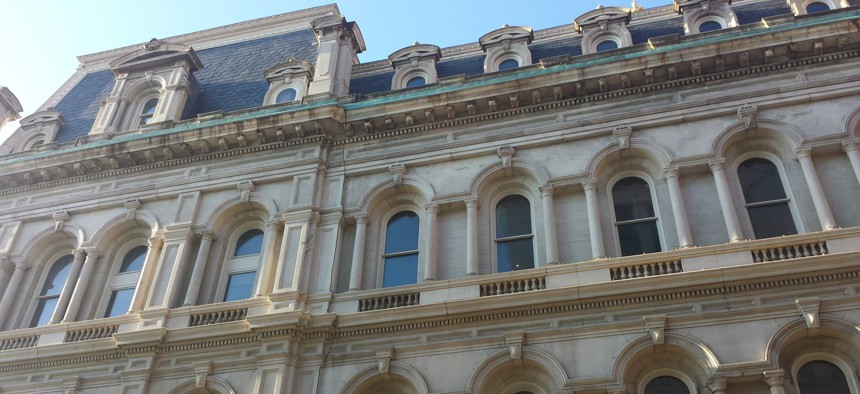Connecting state and local government leaders
Charm City has faced significant challenges in 2015, relations with Maryland Gov. Larry Hogan are tense and the road to recovery is unclear.
Route Fifty is currently featuring dispatches from a city-county summer roadtrip in Maryland, West Virginia, Pennsylvania, Ohio, Michigan and elsewhere along the way. An Introduction to the Series.
BALTIMORE — If you didn’t know that Maryland’s capital city was Annapolis, it wouldn’t be unreasonable to assume that Baltimore’s grand City Hall, which sits near the edge of the central business district, is actually the Statehouse. City Hall’s tall dome, sitting atop a French Renaissance Second Empire-style municipal edifice, certainly outmuscles the more recognizable colonial-era Statehouse that’s 30 miles away, at least in terms of architectural gravitas. (And Baltimore City Hall rivals plenty of other state capitol buildings, too.)
When the seat of municipal government was completed in the 1870s, it was a show palace for a powerful city that had been the nation’s second-largest city in the decades leading up to the Civil War. The City of Baltimore, which is jurisdictionally independent of Baltimore County, had grown quickly in the 19th century as an economically powerful industrial and transportation hub with its valuable port and important rail connections.
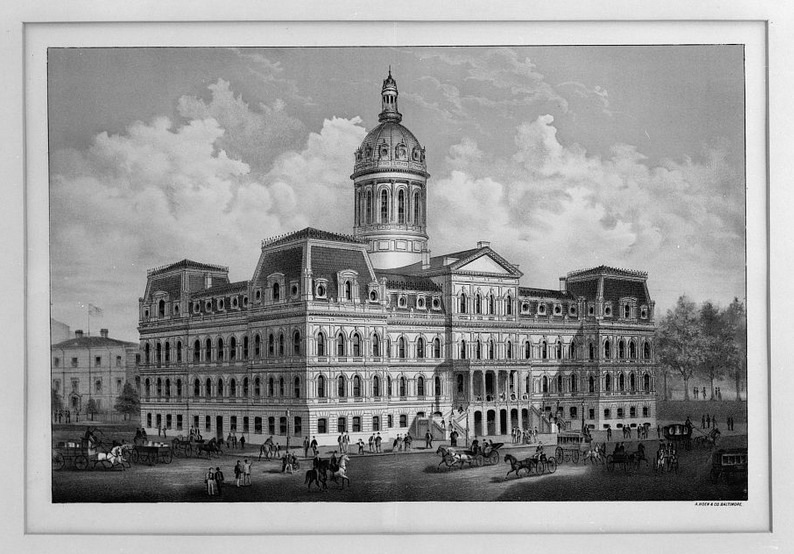
The nation’s capital, about 40 miles to the southwest, had long sat in Baltimore’s shadow as a small-town provincial backwater, even well into into the 20th century. These days, some might argue that those roles have been reversed—the regional relationship between Charm City and D.C. has been complicated to say the least. It’s hard to say exactly where Baltimore’s suburbs end and D.C.’s Maryland suburbs begin.
Baltimore is still certainly one of America’s great cities, one with a deep history and significant cultural and civic footprint.
But it’s impossible to deny that 2015 has been an especially rough year for the city.
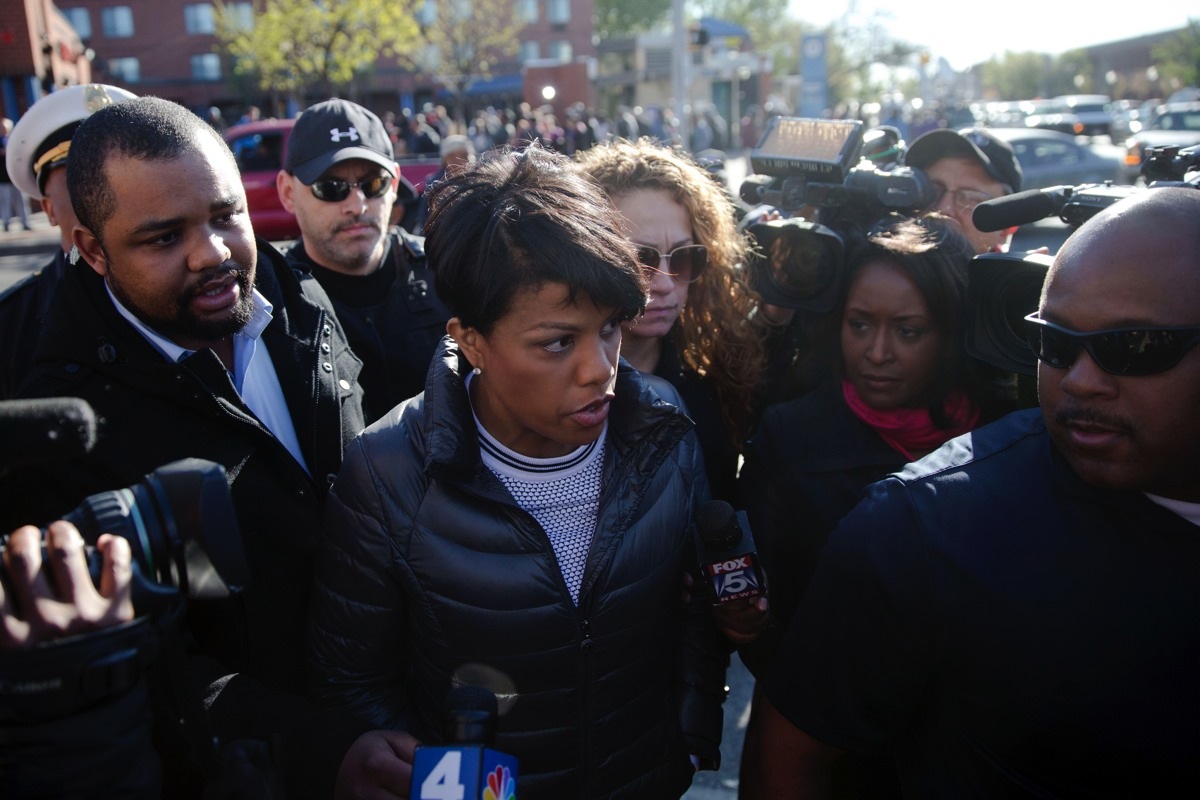
The city was thrust into the spotlight during civil unrest, looting and destruction that played out for the world to see on live TV coverage following the funeral of Freddie Gray, a 25-year-old black man who died of severe spinal cord injuries while in the custody of the Baltimore Police Department. (Six police officers have been charged in connection with Gray’s death and have pleaded not guilty.)
The demands for justice for Gray’s death—and the riots that resulted—has caused a lot of soul searching and has tested city leadership, especially Mayor Stephanie Rawlings-Blake, who took the reins of the National Conference of Mayors presidency this summer.
Civic leaders have stressed Baltimore’s post-riot resiliency and opportunities for the city to come together. But it’s not going to be easy, especially in a city with deep levels of poverty and economic inequality.
Michael Cryor, the director of OneBaltimore, a public-private partnership formed after this spring’s unrest, said during a recent City Council committee hearing that it could take “5, 10, 15 years to realign our culture, our expectations, our preparations, if Baltimore is to move in the direction we want,” Baltimore Brew reported last week.
What’s the way forward? Baltimore leaders regularly trumpet the city’s tech credentials and economic development efforts.
"Our economy relies on continued growth of companies in technology, biotechnology, cyber, education technology, and technology, health IT," Baltimore Development Corp. President William H. Cole IV said in March, according to the Baltimore Business Journal. "Our goal is to energize the tech community in the city and provide funding for companies to grow."
Baltimore City Hall is also working on its smart cities strategy—Rawlings-Blake released a 27-page draft report in June on the subject. “I am grateful to the representatives of our government, business, and nonprofit sectors who invested their time and energy in putting together a thoughtful blueprint,” the mayor said in her announcement. “I believe that their work will help all of Baltimore better integrate technology and innovative thinking into our city’s DNA.”
There’s a legacy of municipal innovation that looms big at City Hall.
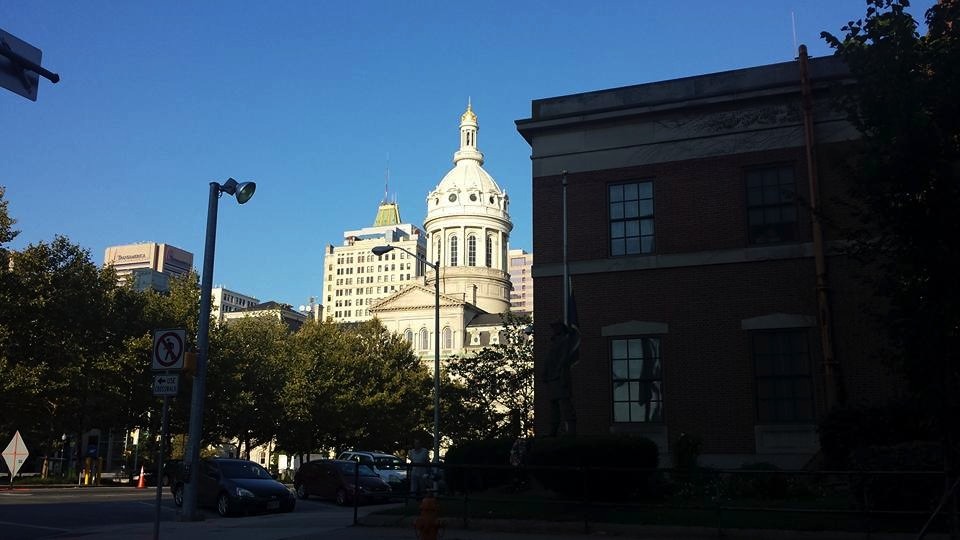
In the 1990s, Baltimore was the first U.S. city to launch a 311 non-emergency call center operation to improve municipal services.
Baltimore’s CitiStat performance-based and data-driven analytics program, which launched when Martin O’Malley was mayor, was a trailblazer and has served as a model for other cities looking to improve city services. But these days, members of the Baltimore City Council have questioned the program’s own performance.
Beyond smart governance, Baltimore City Hall is going to have to work with other civic partners as part of the city’s ongoing post-riot recovery. And it’s going to take a lot of cross-sector collaboration and funding to effectively address the city’s long-term chronic problems that are rooted in poverty and economic inequality.
The challenges Baltimore faces are clearly daunting. So how much will Annapolis champion the state’s largest city? In the current sphere of Maryland politics, the prospects are gloomy. Baltimore no longer dominates the state like it once did.
This has been most pronounced with the election of Gov. Larry Hogan, a Republican with no Baltimore allegiances whose successful 2014 campaign in a state dominated by Democrats shocked the political establishment.
In a recent column in The Washington Post, Robert McCartney wrote about how the new governor has been shifting budget priorities away from Baltimore to other parts of the state that have complained for years about being neglected in favor of the city’s priorities.
Hogan shocked Baltimore leaders when he scrapped the state’s support for the proposed east-west Red Line light-rail line, a top economic development priority for City Hall and neighboring Baltimore County. The governor spared a separate light-rail project, the Purple Line in Montgomery and Prince George’s counties outside Washington, D.C.
The death of the Baltimore’s Red Line, which has come as Hogan has been courting foreign investment for a future maglev high-speed train in his state, marked a low point in the city’s relationship with the state government. (Adding to the frustrations: Hogan’s recent action to close the notorious Baltimore Detention Center was done without any consultation with Baltimore City Hall. “He just did it,” The Sun wrote.)
According to The Post’s McCartney:
Hogan’s tense relations with Charm City already have become one of the early themes of his nearly seven-month tenure. He’s off to a more contentious start with Baltimore than the last Republican governor, Robert L. Ehrlich Jr., who took office in 2003.
If things don’t improve, the city’s struggle with the governor could lead to years of bad feelings. It could add to strains on the city as it tries to recover from the rioting in April after the funeral for Freddie Gray, who died one week after being arrested by Baltimore police and suffering a severe spinal injury, and the surge in homicides that followed.
To many in Baltimore, Hogan’s Red Line cancellation, which was formalized last week in a letter to the Federal Transit Administration, was particularly cruel, like pouring salt on an open wound. And the governor’s decision was perhaps self destructive for Maryland, which still needs a strong and vital Baltimore.
As The Sun’s editorial board wrote in the wake of the Red Line decision:
In a time of need, Baltimore could scarcely have received a message more loudly or clearly that it has no friend in the Hogan administration. Instead, the entire Baltimore region has suffered a major financial reversal with the derailment of light rail and the estimated $2.1 billion in economic activity that would have come with it.
On my way out of town on Sunday morning to continue with my city-county roadtrip, I wanted to check out what might be the biggest physical symbol of a lost opportunity in Baltimore.
To connect with Interstate 70, which would take me westward into the mountains, I drove out along U.S. 40 and look at the so-called “Highway to Nowhere,” a short segment of an unfinished expressway that has torn a hole through struggling West Baltimore neighborhoods along Franklin and Mulberry streets.
The local impacts of this seemingly random stretch of expressway have been written about plenty of times before. It’s a textbook case example of neighborhood decline spurred on by urban freeway construction.
As Reason magazine wrote in May:
It's certainly possible that these neighborhoods would have undergone a gradual economic decline anyway, given the city's deindustrialization and given that the black middle class soon found it easier to move away. But they would not have undergone such a sudden, severe, and destructive drop. And they would not have been replaced by that trench for cars in the Franklin-Mulberry corridor. The highway has been around for decades now, and it's still doing damage, by severing one section of the city from another and by discouraging any development near it.
While the “Highway to Nowhere” may seem today like a big waste, it’s in some ways the city’s most valuable underutilized transportation asset. The Red Line was to have used the expressway’s right-of-way. It’s a no brainer. And using that existing ditch for transit instead of having to dig a longer crosstown light-rail subway tunnel makes sense for any future transit investment.
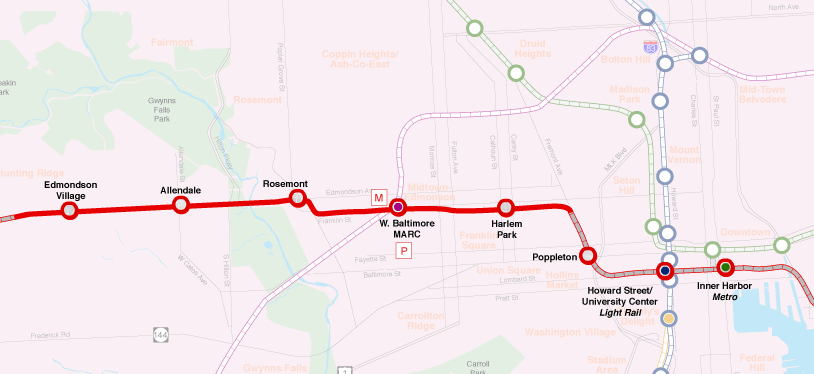
The Red Line’s stations in this part of town would have helped spur investment and heal the gash. The light rail line’s connection with MARC commuter services to Washington Union Station would have been, and still is, a nice advantage for West Baltimore.
But the long-hoped for economic investment won’t be materializing anytime soon, at least under the current governor.
The list of major transportation investments is long in Maryland. And Hogan, like New Jersey Gov. Chris Christie, has a problem with Amtrak tunnels and bridges, too.
In the case of Christie, it’s the ticking clock on Amtrak’s aging and deteriorating Hudson River tunnels into New York City which face a necessary replacement and capacity expansion (though no consensus on how to fund them), plus improvements to aging bridges on the Northeast Corridor.
For Hogan, it’s Amtrak’s Baltimore & Potomac tunnels, an aging chokepoint for Amtrak and commuter trains on the busy Northeast Corridor. Like the Hudson River tunnels, the ones Amtrak uses in Baltimore are ancient—they opened in the early 1870s—and any future high-speed rail improvements on the Northeast Corridor will necessitate new tunnels through Baltimore, plus replacement of Amtrak’s bridge over the Susquehanna River. (That replacement might happen in the 2020s, if funding is available.)
Transportation planning in Maryland—and especially in Baltimore—has been a messy affair over the years and the Red Line’s $2.1 billion proposal was far from perfect, especially the costly 3.4 mile light-rail subway tunnel through downtown which had a roughly $1.5 billion pricetag on its own. Baltimore Brew’s Mark Reutter has argued that Hogan did Baltimore a favor by canceling the flawed Red Line plan. But will his administration offer a more sensible alternative to improve Baltimore’s unmet transportation needs?
Hogan’s recent infrastructure decisions suggest his priorities are outside Baltimore and long-term transportation strategy involves futuristic maglev trains making their way through what The Washington Post has described as “the most congested and perhaps litigious part of the country.” And such a system would require a far more costly investment than the Red Line in Baltimore.
Maryland’s transportation needs are great. So too are Baltimore’s. And those needs are intertwined and there’s no easy way forward.
It’s time to head west.
Next Stop: Frederick, Maryland.
Michael Grass is Executive Editor of Government Executive’s Route Fifty.

NEXT STORY: Some Relief for Oregon Neighborhood Facing Onslaught of Government Beetles
